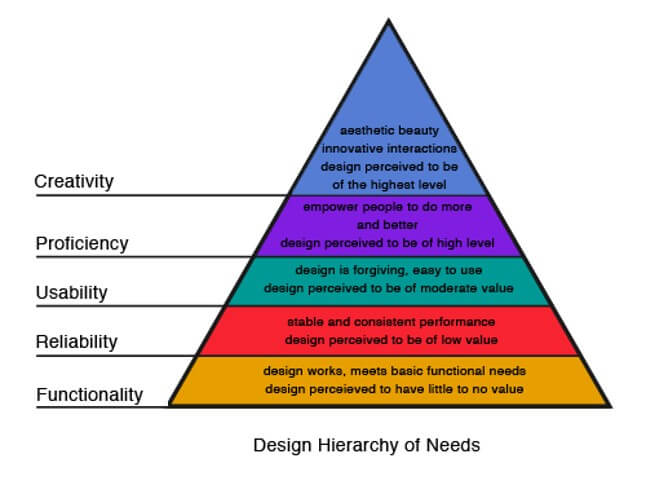Product design is a delicate balance between what the entrepreneur wants the product to be and what the end-user actually needs. Need v. Want comes up in our everyday life, and it is no different when you are designing a product for consumers. Often, the entrepreneur will think that they know what the customer needs, but without actively asking potential customers they could be missing the mark.
Product Design Hierarchy of Needs
Recently we came across the Design Hierarchy of Needs, from Stephen Bradley, (writing for Smashing Magazine) which is based on the same concept as Maslow’s Hierarchy of Needs. “Abraham Maslow’s, the American psychologist, is most famous research examined human motivation. In 1943 he published his paper; A Theory of Human Motivation. In this paper he revealed his understanding of human needs and proposed that they formed a hierarchy from the most basic to the most complex. He suggested that in order for a human being to be satisfied they must meet of all their needs. However, the most basic needs must be fulfilled before higher level needs can be met satisfactorily.” (Interaction Design Foundation)

Stephen Bradley took Maslow’s concept and amended it to provide a useful guide for developing products which deliver high-levels of value to the customer.
Adding Value Through Product Design
Functionality. Before anything else, a product must be functional. It must meet the most basic needs of the customer. “Designs that meet only basic functionality needs are considered to be of little to no value. A design is expected to meet basic functionality needs; doing so isn’t considered anything special.” (Smashing Magazine)
Reliability. Once your product design has fulfilled the basic functionality requirement, it can now move up to reliability. At this level your product is expected to successfully preform a function, over and over again without failing. Your product should exhibit stable and constant performance. If you have a product that works 90% of the time but fails the other 10%, it is not meeting the customers reliability needs.
Usability. Now that your design is reliable, it is time to examine its usability. Can a customer pick up your product and easily figure out how to use it? For example, are the buttons easy to navigate, is it easy to understand, is the product design forgiving if an incorrect button is pushed? “Usable designs are perceived to be of moderate value. We do have some basic expectations of usability, but we recognize that many things don’t quite work as we expect or would like.” (Smashing Magazine)
Proficiency. “Designs regarded as proficient are perceived to function at a high level. A design that allows people to do things not previously possible and to expand on basic functionality is considered to be great.” (Smashing Magazine) Is your product allowing your customer to do things that they once were unable to? If your product is adding value to their everyday life and making things easier, you are on the right track.
Creativity. Once the lower-level needs have been met, your product design can focus on creativity. An iconic corporate example of success at this level is Apple. Their products meet all of the basic needs and then excel when it comes to innovation and creativity. Designs that meet creative needs are perceived to be of the highest level.
Just like in Maslow’s Hierarchy of Needs, the Design Hierarchy of Needs can be looked at with a critical eye. Will consumers buy a product that useable but not necessarily reliable all the time? Or a product that is highly creative but not exactly proficient?
The Design Hierarchy of Needs is a good starting point during the product development process. As an entrepreneur, you can look at your product, or product idea, through this lens and determine where your product excels, and which areas need a little more help before your product design is finalized.
References
- Smashing Magazine: “Designing For A Hierarchy Of Needs”
- Interaction Design Foundation: Needs Before Wants in User Experiences – Maslow and the Hierarchy of Needs
_______
3D Innovations is a Product Development Company – from the 3D Design to a fully functional 3D Prototype & Product.
Subscribe to the 3D Innovations newsletter on our Facebook page!

